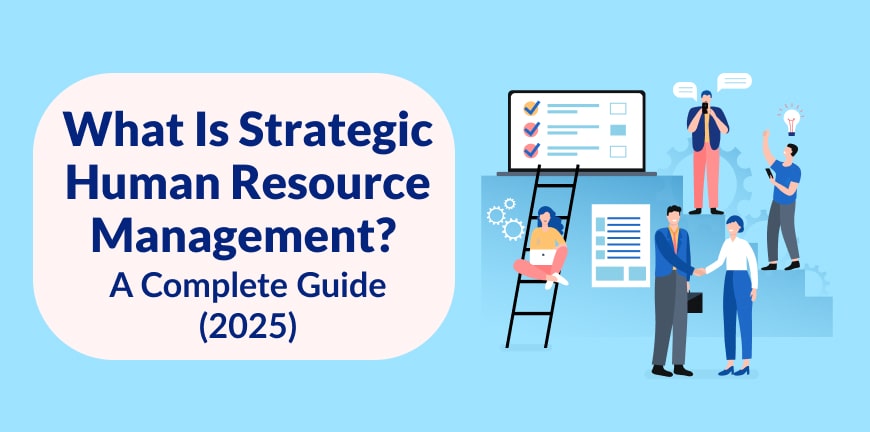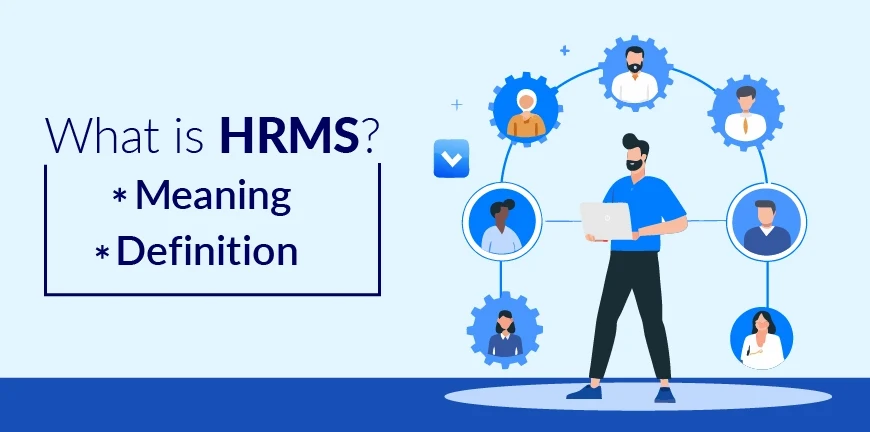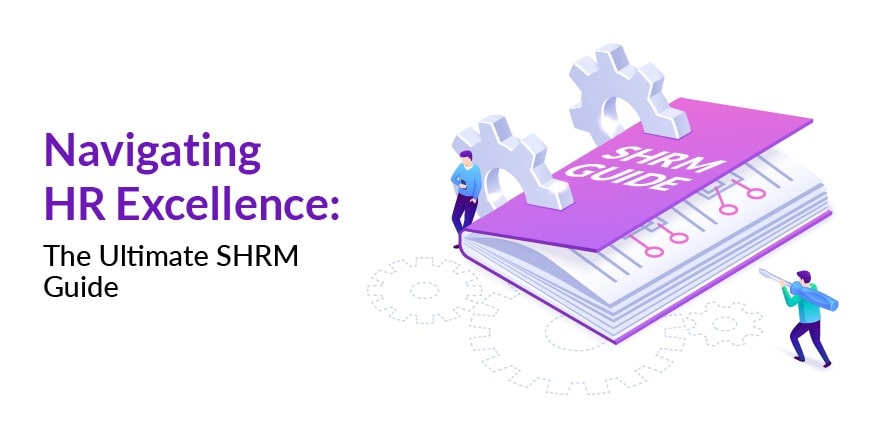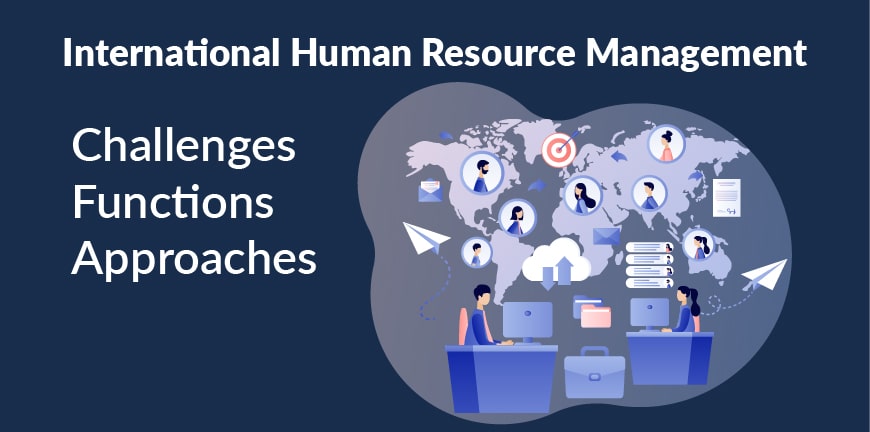
How To Hire a Mobile App Developer in 2025
26/08/2025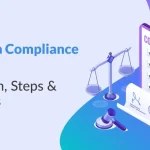
What Is a Compliance Plan? Definition, Steps & Examples
26/08/2025- What is Strategic Human Resource Management?
- How does SHRM differs from traditional HRM?
- Strategic Human Resource Management: Meaning in today’s business context
- Core Characteristics and Features of Strategic Human Resource Management
- What are the Strategic Human Resource Management Models?
- Why Strategic Human Resource Management Delivers Business Results
- The Strategic Human Resource Management Process
- What are the Objectives and Scope of SHRM?
- What are the Challenges in Implementing SHRM?
- What is the Role of People Analytics in SHRM?
- Building Your Strategic HR Success
- Conclusion
- Key Takeaways
- Frequently Asked Questions (FAQs)
“The value of a business is a function of how well the financial capital and intellectual capital are managed by human capital. You’d better get the human capital part right.” — Dave Bookbinder, Valuation expert and author of ‘The New ROI: Return on Individuals’
In this current business landscape, the margin of error is very minimal, and companies must leverage every available resource and turn it into a competitive advantage. Strategic human resource management is one such tool that can help companies build a strong and loyal workforce that aligns perfectly with business objectives and goals with minimal supervision.
So, what is strategic human resource management definition and how can we implement it in the best possible way? Let’s engage in a detailed discussion and get the right answers so that we can create and deploy a sustainable strategic human resource management process that will generate the desired outcomes in the long run.
What is Strategic Human Resource Management?
The concept of strategic human resource management emerged in the early 1990s, changing how businesses approach workforce management. This evolution moved organizations from conventional personnel administration to integrated business functions that drive competitive advantage.
Definition of strategic human resource management
Strategic human resource management definition states that” Strategic human resource management (SHRM) is a framework connecting people management and development practices to long-term business goals and outcomes.” Additionally, SHRM establishes coherent systems for hiring, managing, and developing employees to support organizational objectives. Wright and McMahan elaborate on the strategic human resource management meaning in a different way as “the pattern of planned human resource deployments and activities intended to enable the organization to achieve its goals”.
The strategic human resource management process involves systematic management of people: organizations’ most valuable assets. This arrangement ensures alignment between HR strategies and broader business goals. Also, this alignment develops policies, programs, and practices that work in harmony with the strategic direction.
How does SHRM differs from traditional HRM?
Traditional HRM focuses on operational tasks and day-to-day administration. SHRM takes a strategic orientation with several key distinctions:
- Focus and timeframe: Traditional HRM concentrates on short-term operational activities, while SHRM adopts long-term perspectives focused on future needs. Traditional HRM responds reactively to issues as they arise, whereas SHRM anticipates future workforce requirements proactively.
- Approach and orientation: Traditional HRM handles administrative functions separately from business strategy. SHRM integrates HR strategies with organizational strategic plans. This integration positions HR as part of leadership teams, fully aware of both short and long-term company objectives.
- Role in organization: Traditional HRM positions HR managers as administrators. SHRM elevates them to strategic partners contributing to business strategy development. Caitlin Weiser explains, “Aligning HRM with overall business strategy is about understanding what employee behaviors are needed to support long-term business goals”.
Strategic Human Resource Management: Meaning in today’s business context
SHRM has become essential for competitive advantage in contemporary business environments. Additionally, modern SHRM develops talent management frameworks that influence organizational behavior and culture, aligning them with business objectives.
SHRM adds tremendous value to organizations through several crucial methods. It connects employees with organizational goals, ensuring HR practices link workers with company paths to achieving broader objectives. Additionally, strategic human resource planning enables companies to gain a competitive advantage by focusing on developing the skills and abilities necessary for future success. Moreover, it enables adaptability, allowing organizations to anticipate and respond quickly to business environment changes.
The importance of strategic human resource management can’t be undermined at any point in time, as it plays a decisive role in managing cross-cultural teams, embracing HR technology, and integrating diversity initiatives. Also, organizations can adapt to technological advancements, market shifts, and evolving workforce demographics through strategic HR approaches.
The strategic approach recognizes that no single HR strategy guarantees success for all organizations. Companies must define unique strategies according to specific contexts, cultures, and objectives. Organizations build upon and improve their strategic HR approaches through continuous monitoring and refinement over time.
Core Characteristics and Features of Strategic Human Resource Management
Strategic human resource management operates through three distinct characteristics that separate effective workforce management from traditional administrative approaches. These features create the foundation for how businesses can build competitive advantage through their people strategies.
1. Long-term focus and proactive planning
Strategic HRM takes a future-oriented approach rather than simply reacting to immediate workforce issues. This perspective involves planning horizons spanning one to five years to ensure adequate capacity for future business needs.
Proactive workforce planning becomes essential as businesses navigate rapid technological changes and global market shifts. Companies address skills gaps, succession planning for retirements, and diversity goals through systematic workforce planning, ensuring organizational resilience in dynamic environments.
The strategic human resource planning follows a three-pillar framework:
- Assessing current state: Capabilities, resources, needs, and gaps
- Defining desired future state: Vision, business objectives, and required competencies.
- Determining transition path: Strategies, investments, and changes needed to bridge current and desired states.
Research from Deloitte reveals that only 11% of organizations demonstrate strategic maturity in their workforce planning approach. Also, this statistic highlights significant opportunities for businesses to improve their proactive HR strategy integration with organizational goals.
Strategic alignment between HR strategies and business objectives forms a fundamental SHRM characteristic. This integration ensures HR practices, policies, and strategies directly connect employees with the company’s path toward achieving organizational goals.
Effective strategic alignment extends across all departments, like finance, operations, and management, ensuring unified contribution toward shared objectives. This integration positions HR as a strategic partner in business strategy development rather than an isolated administrative function.
Organizations that quickly reallocate employees to high-priority initiatives outperform their competition by more than two times. Strategic alignment creates a competitive advantage by developing skills and capabilities required for future success.
2. Employee-centric and data-driven approach
Modern objectives of strategic human resource management place employees at the center of organizational strategies, recognizing workforce members as active contributors rather than passive policy recipients.
Organizations with employee-centric cultures experience:
- Higher productivity and retention rates.
- Enhanced customer service quality.
- Superior financial performance outcomes.
Willis Towers Watson research demonstrates a strong relationship between positive employee experience and superior financial performance. High-performing companies focus on how employees connect with the organization’s mission, achieve career objectives, and build trust with management.
Data-driven decision-making has become essential for effective SHRM implementation. Gartner research shows organizations using big data and analytics experience 15% productivity increases. Additionally, 78% of CHROs report that their organizations rely on talent data for strategic decisions.
Data-driven HR moves beyond intuition and opinion, using advanced analytics to identify patterns, predict trends, and develop strategies that improve both employee experience and return on investment. Also, success requires selecting metrics that provide insight into HR processes while demonstrating clear connections to business outcomes.
What are the Strategic Human Resource Management Models?
Organizations implement strategic human resource management through various proven frameworks. These models help businesses align their HR practices with overall business objectives, each offering a distinctive approach to workforce management success.
1. Best-fit model
The best-fit model, known as the contingency approach, demonstrates that HR strategies become more effective when tailored to your organization’s specific business environment. Rather than assuming universal solutions work everywhere, this model focuses on developing HR policies that match your business strategy and context.
Additionally, the HR strategies must align key factors, including business strategy, organization size, technology, geographic location, labor market conditions, industry sector, and economic circumstances. A startup company requires different HR approaches than an established corporation based on their distinct development stages.
The best-fit approach faces practical challenges. Companies operating in rapidly changing business environments struggle to frequently adjust entire HR systems to address new challenges. Also, as businesses evolve through their life cycles, constantly aligning HR practices might create inconsistent employee treatment, potentially affecting motivation and corporate culture.
2. Best-practice model
The best-practice model, also called the universalistic approach, argues that specific bundles of HR activities help companies achieve competitive advantage regardless of organizational setting or industry. This framework suggests certain HR practices consistently drive superior organizational performance across all business contexts.
Additionally, high-commitment management exemplifies this approach through practices like selective hiring, extensive training, employment security, employee participation, and competitive pay policies that create motivated workforces. Organizations adopting these universal best practices can maximize performance regardless of their market strategy.
Standardized best practices in strategic human resource management carry risks. Organizations might introduce conflicting combinations such as team working alongside individual performance-based compensation, which can reduce employee collaboration. High-commitment management systems require substantial planning and top-level management commitment for successful implementation.
3. Resource-based view model
The resource-based view (RBV) model positions your organization’s sustainable competitive advantage on the strength of internal resources. Unlike models focusing on external factors, RBV emphasizes competitive advantage within your business.
This framework evaluates resources through four criteria: Value, Rareness, Inimitability, and Organization (VRIO). Your human resources become strategic assets when they create value that competitors cannot easily replicate. Also, complementary HR practices generate greater competitive advantage because their combined effect proves more difficult to imitate than individual best practices.
Research validates this approach, showing stable differences in HR practices between firms that industry factors alone cannot explain. Internal resource management significantly influences organizational performance beyond external market conditions.
4. High-performance work system model
The high-performance work system (HPWS) model creates work environments that drive enhanced performance through improved HR practices. This approach increases employee autonomy, promotes loyalty, and establishes continuous learning cultures.
HPWS incorporates three essential elements: employee involvement, coaching and development, and rewards and recognition. Empowering employees through training and decentralized decision-making drives business success.
HPWS effectiveness shows measurable results. McKinsey research found companies with strong work cultures (a core HPWS outcome) delivered three times higher returns. Public hospitals implementing HPWS increased both efficiency and service quality.
The HPWS model treats employees as a source of creating a competitive advantage rather than as expenses. Also, organizations focusing on intellectual capital, employees’ skills, training, and knowledge build a sustainable competitive advantage in their industries.
Why Strategic Human Resource Management Delivers Business Results
Organizations that recognize human resource management’s direct impact on their bottom line gain measurable advantages across multiple business dimensions. Strategic human resource management creates value far beyond administrative functions, delivering concrete results that drive organizational success.
1. Connecting HR Strategy to Business Performance
Research consistently shows organizations’ benefit when HR strategies connect directly with business objectives. True alignment requires shared ownership, clear communication, and continuous connection to what drives your organization. Also, Companies that integrate HR activities like recruitment, retention, and training into their overall business strategy gain a competitive edge for long-term success.
High-performing HR systems built on strategic workforce planning, targeted skill development, and performance-based rewards link directly to stronger profitability, productivity, and shareholder value. HR alignment with business strategy drives higher levels of employee engagement and commitment, which boosts customer satisfaction and market share.
2. Building Engaged and Committed Teams
Strict HR rules contribute more to productivity than to improving employee engagement and retention. Fewer than one-third of all employees are engaged in their work, with engagement barely changing over the past 15 years despite organizations spending approximately INR 126.57 billion annually to address it.
Disengaged employees create tangible costs, with some studies estimating losses amounting to 23% in profitability. Happy employees are up to 20% more productive. Also, retention/turnover, employee engagement, and succession planning are ranked as the top challenges facing HR according to most surveys.
3. Driving Measurable Performance Gains
Organizations with effective SHRM practices experience significant performance improvements. Turnover results indicate that HR effectiveness explains a 9% increase in variance over control variables, suggesting that effective HR systems contribute to turnover reductions.
SHRM enables businesses to optimize workforce planning and talent management processes. You can forecast future talent needs and develop strategies to attract, develop, and retain top talent, reducing recruitment costs, minimizing turnover, and improving employee productivity.
Before implementing SHRM, many organizations struggle with cross-functional misalignment and ineffective talent management. Strategic human resource management process helps identify key skills and competencies needed to execute business plans successfully, while managing talent risks to minimize disruptions, maintain positive work environments, and ensure regulatory compliance.
The Strategic Human Resource Management Process
Effective workforce management requires a systematic and orderly approach to aligning your people’s practices with business objectives. We provide a structured process that builds upon key stages to ensure your HR activities support business success.
1. Understanding business goals
HR professionals must first develop a thorough understanding of the organization’s vision, mission, and long-term plans. This foundational step involves engaging with senior leadership to gain clarity on what your business hopes to achieve over the next one to five years. Additionally, the HR teams gather insights into past achievements, current offerings, and future aspirations through discussions with stakeholders throughout the organization.
This environmental scanning covers both external factors like political, legal, technological, economic, social, and cultural forces, and internal elements like organizational culture, hierarchy, and business processes. The HR departments of companies should also collect information about immediate competitors, including their strategies, workforce composition, and potential strengths and weaknesses.
2. Assessing current HR capabilities
After establishing clarity on business objectives, evaluate your current HR capabilities. This assessment identifies where your organization excels and where it needs improvement. A skills inventory for each employee reveals expertise areas and potential interest in additional training.
The gap analysis compares your current workforce capabilities with future needs to identify conflicts or discrepancies. This analytical process examines both demand (predicting the number of employees needed to meet future goals) and supply (taking inventory of available employees and skills).
3. Developing HR strategies
The HR professionals develop strategies to address identified gaps and support business objectives. This stage involves creating specific HR techniques to enhance employee performance and maximize their value to your organization.
Effective strategies include talent management initiatives, employee engagement programs, development plans, and succession planning. These approaches focus on creating conditions that foster employee growth while directly supporting your organizational goals.
4. Implementing and monitoring
The final phase puts strategies into action through HR policies, plans, and practices. Successful implementation requires establishing clear timelines, assigning responsibilities, and allocating necessary resources. Regular communication and feedback from employees help ensure successful adoption throughout execution.
Strategic HR management requires consistent measurement and feedback loops rather than a “set it and forget it” approach. Monitoring results involves comparing performance against pre-established standards and analyzing deviations. This evaluation process tracks progress through key performance indicators (KPIs) that measure how successfully your HR strategy supports business objectives.
What are the Objectives and Scope of SHRM?
“Businesses often forget about the culture, and ultimately, they suffer because you can’t deliver good service from unhappy employees.” — Tony Hsieh, Former CEO of Zappos, entrepreneur, and culture advocate.
Strategic human resource management establishes specific objectives that drive measurable business results. These objectives of strategic human resource management form the foundation for how professional HR departments contribute to organizational success through systematic workforce management.
1. Enhancing workforce productivity
Strategic HRM focuses primarily on increasing employee productivity through targeted interventions. Companies implementing productivity monitoring tools often see positive impacts, as these tools help identify performance gaps and improvement areas. Additionally, SHRM boosts business performance by improving working conditions and providing employees with opportunities to contribute more effectively.
Strategic HRM enhances employee performance through systems that ensure workers remain motivated, well-trained, and properly evaluated. HR professionals address employee weaknesses while reinforcing strengths, leading to optimal job performance and productivity.
2. Building a strong organizational culture
SHRM shapes and maintains an organizational culture that aligns directly with business goals. Strategic human resource management helps design interventions to enhance workplace culture, promote company values, and improve employee engagement.
Organizations with strong work cultures showed three times higher returns in McKinsey research. Employee morale increases under effective SHRM practices, allowing team members to work with reduced stress while taking on new challenges.
3. Supporting innovation and adaptability
Strategic human resource management drives innovation while ensuring organizations adapt to external changes. SHRM creates environments where employees feel supported, empowered, and ready to face change.
SHRM prepares organizations for future challenges through:
- Workforce planning for future demands and disruptions
- Talent development through training and growth opportunities
- Clear communication that keeps teams aligned and involved.
- Inclusive policies creating environments where everyone contributes.
Strategic HRM enables businesses to remain agile by fostering adaptable and resilient workforces. Strategic human resource planning ensures businesses respond quickly to change by predicting future challenges and opportunities. SHRM fosters innovation by providing employees with the freedom to explore creative solutions that drive business growth.
What are the Challenges in Implementing SHRM?
Well-designed strategic human resource management frameworks can face implementation hurdles that limit their effectiveness. Organizations that understand these challenges of strategic human resource management prepare more thoroughly for successful SHRM initiatives.
1. Cross-functional misalignment
Organizations struggle with cross-functional misalignment, often leading to delivery failures and compromised customer trust. This disconnect frequently occurs when Product Managers commit to roadmaps without validating feasibility with Engineering and Program counterparts. Each function, like Product, Engineering, and Program, may work toward the same goal yet operate in silos.
The absence of strategic integration undermines plans as workforce talent priorities need to be embedded within organizational goals through robust cross-functional coordination. Also, successful SHRM implementation requires breaking down these departmental barriers to ensure all teams work cohesively.
2. Resistance to change
Resistance represents a natural human reaction to change, an emotional and psychological response when individuals face uncertainty or perceive threats. Common drivers of resistance include lack of awareness about reasons for change, fears concerning job security, poor leadership engagement, and comfort with current routines.
Research shows that organizations planning for resistance meet project objectives, while those failing to plan typically miss their goals. Addressing resistance proactively through transparent communication, early stakeholder involvement, and visible leadership support creates smoother transitions.
3. Global and cultural complexities
Implementing SHRM across borders introduces challenges in managing culturally diverse workforces. Cultural variations in communication styles, decision-making processes, and work-life balance expectations can create misunderstandings. Also, HR professionals must navigate different legal frameworks while maintaining consistency in policies across borders.
Organizations with above-average diversity had higher innovation revenues and higher EBIT margins on average, yet capitalizing on these advantages of strategic human resource management requires skillful navigation of cultural nuances.
4. Technology integration issues
Technological challenges often hinder SHRM implementation, including system integration problems, data security concerns, and a lack of technical capabilities. Organizations struggle with combining new software with existing infrastructure, protecting sensitive employee information, and ensuring staff members receive necessary training for rapidly advancing technology.
Change management becomes particularly crucial during technology implementation, with approximately 40% of organizations facing resistance during this process. Effective integration requires close collaboration between HR and IT departments to address these technical hurdles.
What is the Role of People Analytics in SHRM?
Data drives successful strategic human resource management in today’s competitive business environment. Research shows that more than ninety percent of business leaders believe people analytics elevate the HR profession, while around seventy percent of HR executives who use it report that analytics is essential to their organization’s HR strategy.
1. Making informed HR decisions with data
People analytics replaces guesswork with objective insights into your HR practices. This approach enhances decision-making effectiveness while allowing your HR professionals to focus more attention on innovation and strategy. Also, organizations now use data to evaluate HR process efficiency, employee productivity, diversity initiatives, and other key business metrics.
2. Tracking performance and engagement metrics
Measuring engagement helps your HR teams understand and influence crucial outcomes like productivity, innovation, and customer satisfaction. Analytics enables your organization to identify engagement drivers and accurately measure satisfaction levels. Also, companies can pinpoint potential issues before they escalate, either through declining performance metrics, high turnover rates, or low employee morale. Moreover, early identification allows for proactive implementation of solutions that maintain a healthy organizational culture.
3. Predicting future workforce requirements
The predictive capabilities of people analytics have evolved significantly in recent years. Organizations can now use AI-powered analytics to anticipate skill shortages, forecast talent demands, and develop succession plans.
Also, companies can prepare for retirement, identify employees with leadership potential, and invest in relevant training programs. Advanced models incorporate external labor market data, industry trends, and economic indicators to anticipate future skill requirements and talent availability.
People analytics continue to change how organizations approach human resource management, creating more data-driven, forward-looking workforce strategies that deliver measurable business results.
Building Your Strategic HR Success
Strategic human resource management succeeds when leadership commits across all organizational levels. Senior executives must champion SHRM initiatives while managers throughout your company support implementation. This partnership approach ensures your HR strategies stay connected with business objectives.
Organizations maximize SHRM effectiveness through regular performance reviews against established benchmarks. You should adjust your approaches based on findings to maintain alignment with changing business goals. Additionally, open communication channels between HR and other departments create a better understanding of how people strategies support organizational success.
Technology integration continues to reshape SHRM practices. AI and machine learning tools now help forecast staffing needs, identify skill gaps, and personalize employee development paths. Employee well-being has become equally important as organizations recognize that workforce health directly impacts productivity and innovation capacity.
Successful organizations will continue adapting their SHRM approaches to address changing workforce demographics, remote work arrangements, and global talent competition. The fundamental principle remains constant: aligning human resource strategies with business objectives creates measurable advantages in productivity, innovation, and organizational resilience.
Whether you are a startup on a growth trajectory or a large organization looking to optimize your talent pipeline, strategic human resource management provides the framework for sustainable workforce success. We help organizations build systematic approaches to attract, develop, and retain top talent while ensuring compliance and maximizing productivity.
Conclusion
Strategic human resource management serves as your foundation for building competitive advantage through effective people management. Companies that embrace this systematic approach experience measurable improvements in productivity, engagement, and business performance. Your workforce becomes a strategic asset rather than an operational cost.
Business environments change rapidly. Your SHRM approach must evolve alongside market conditions and workforce expectations. Companies that view employees as strategic investments position themselves for sustainable growth and market leadership.
ALP Consulting helps organizations implement strategic human resource management frameworks that align people strategies with business success. Our systematic approach to workforce planning, talent development, and performance management ensures your HR initiatives support organizational objectives while building employee engagement and retention.
Key Takeaways
- Strategic Human Resource Management transforms HR from administrative tasks into a strategic business function that drives competitive advantage through aligned workforce strategies.
- SHRM aligns people with profits: Organizations linking HR strategies to business goals see 3x higher returns and measurable improvements in productivity and profitability.
- Data drives better decisions: 94% of business leaders believe people analytics elevate HR, enabling predictive workforce planning and proactive problem-solving.
- Long-term focus beats reactive approaches: SHRM emphasizes 1–5-year planning horizons, anticipating future talent needs rather than responding to immediate crises.
- Employee engagement directly impacts bottom line: Engaged employees are 20% more productive, while disengaged workers cost organizations 23% in profitability losses.
- Integration across departments is essential: Successful SHRM requires breaking down silos between HR, finance, and management to ensure unified strategic execution.
Frequently Asked Questions (FAQs)
1. What exactly is strategic human resource management?
Strategic human resource management (SHRM) is an approach that aligns HR practices with an organization’s long-term goals. It involves creating a framework for hiring, managing, and developing employees in a way that supports overall business objectives and drives competitive advantage.
2. What are the key components of strategic HRM?
The key components of strategic HRM, often referred to as the 5 P’s, are: Purpose (aligning with organizational goals), Principles (core values guiding HR practices), Processes (HR systems and procedures), People (workforce management), and Performance (measuring and improving outcomes).
3. Can you provide an example of strategic HRM in action?
A healthcare provider implementing SHRM might focus on building a reputation as an employer of choice through leadership training and employee wellness programs. This strategy attracts top medical talent, reduces recruitment costs, and ultimately improves patient care, aligning HR practices with the organization’s core mission.
4. How does strategic HRM differ from traditional HR management?
While traditional HR management focuses on day-to-day administrative tasks, strategic HRM takes a long-term, proactive approach. It integrates HR strategies with overall business objectives, positioning HR as a strategic partner rather than just an administrative function.
5. What role does data play in strategic human resource management?
Data and analytics play a crucial role in strategic human resource management by enabling evidence-based decision-making. Organizations use people analytics to inform HR strategies, track performance and engagement, forecast workforce needs, and measure the impact of HR initiatives on business outcomes.
Contact Us For Business Enquiry

Rajkumar Shanmugam
Rajkumar Shanmugam is the Head of HR at ALP Consulting, bringing over 19 years of comprehensive HR leadership experience across India and international markets. His expertise spans talent acquisition, employee relations, performance management, compliance, and HR transformation. Rajkumar has a proven track record of driving people-centric initiatives, enhancing workplace culture, and aligning HR strategy with business goals. With extensive experience in US staffing operations and global mobility, he continues to lead organizational excellence through innovation and employee engagement.

